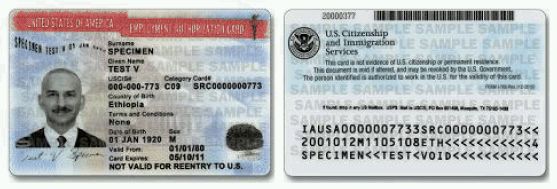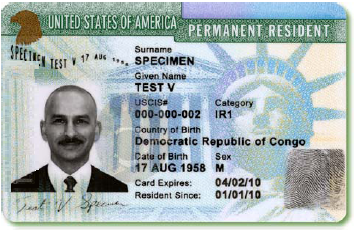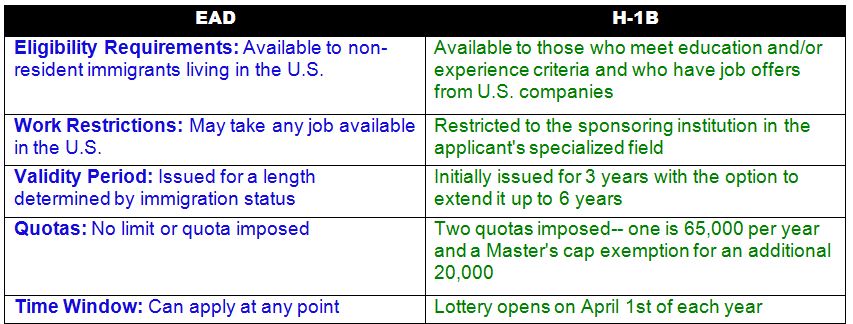EAD Card vs Green Card
When individuals contemplate immigrating to the United States, their first thought usually sways towards a green card. While this may be the ultimate goal, there are other options available that would allow you to work in the United States until a green card is issued. Employment Authorization Documents (EAD) are granted when an individual has a pending Immigration Petition for Permanent Residence or I-485. The card permits non-citizens to legally work in the United States for a U.S. employer. In this post, we’ll explore the similarities and differences between EAD cards and green cards as well as the timeline and process.
IMPORTANT UPDATE: There is a significant advancement of Priority Dates in EB-3 India category in October 2020 VISA BULLETIN. if you are considering downgrading your petition from EB-2 to EB-3, read THIS ARTICLE.
Difference Between EAD Card vs Green Card
While the employment authorization card (otherwise known as a work permit) and the green card share similar physical characteristics, they are very different in practice. For starters, a green card is an end goal while an EAD card is a means to achieve that goal.
A green card’s main purpose is to identify a foreign individual as a person who has lawful permanent resident status. By law, employers in the U.S. are required to make sure all of their employees have the proper authorization to work in the country. Some of the differences are as follows:
A Green Card Serves Multiple Purposes
A green card gives you both lawful permanent resident status and the legal right to work in the U.S. With your green card, you do not need any other document to prove your eligibility to work since that is an inherent benefit of the green card or citizenship.
On the other hand, an EAD is not a stand-alone document on its own. You cannot just come to the United States solely for the purpose of applying for an EAD. It must be tied to an underlying status, to which the EAD will be issued. This may be via a work visa or other means.
Opportunity to Travel Internationally
Another advantage that green card holders possess is the ability to travel freely in and out of the country. If you travel abroad during your stay in the U.S., you will need to provide certain documents to validate your eligibility to reenter the country. With your green card, you will be granted re-entry. You cannot achieve this with just an EAD. To travel in and out of the U.S. as an EAD holder, you must file for a travel document with the I-131 form.
As a green card holder, you have the legal ability to sponsor your immediate foreign relatives to also become permanent residents (green card holders) in the U.S. An EAD, on the other hand, does not grant you this privilege. To file immigrant petitions for family members, you must be a green card holder or U.S. citizen.
Permanent Over Temporary
Validity is another major difference between an EAD and a green card. A permanent green card is typically issued with a ten-year validity period. However, because it is a permanent status, you can always renew it and continue working and living in the U.S. for as long as you’d like.
I contrast, an EAD is issued based on your underlying status in the U.S. If the underlying status ends, your right to work in the U.S. also comes to an end. For example, you may apply for a work permit because you have a pending work visa application. However, if the application is denied, your work permit will become invalid.
Qualification for Citizenship
The United States citizenship law allows foreign nationals to become U.S. citizens through naturalization. Citizenship status gives you the highest privileges in the United States that other statuses don’t enjoy. For instance, you can vote and run for a public office during elections. However, citizenship is only attainable for foreign nationals who have already attained lawful permanent resident status. You cannot become a citizen on the basis of being an EAD holder.
Compared to a green card, an employment authorization card (or work permit) is much more limited in what you can do, although it is available to a wide range of non-immigrant categories as well as those waiting for pending applications with USCIS. What’s more, unlike green cards, EAD cards can range in their validity period depending on the status of the card holder.
For instance, an individual who is in the U.S. on a fiance/K1 visa may likely apply for an employment authorization card that lasts only 90 days. It’s also worth noting that green cards granted to lawful conditional residents are only valid for a period of two years. In these instances, if the proper steps are not taken to adjust the status to permanent residency, the status has a finite lifespan.
However, once those conditions are lifted and permanent residency is granted. Your green card typically has a validity period of ten years.
Similarities Between a Green Card and EAD
Rights to Renew Status
Both the green card and EAD are usually issued with the provision to renew. While the green card is generally known as a permanent resident card, it is worth knowing that, in some cases, the validity period can initially be just two years. This is called a conditional green card, which indicates that the holder is in a probationary period. You will be required to follow the necessary procedures to remove those conditions and get your permanent (non-conditional) green card with the typical ten-year validity period.
Similarly, an EAD is typically issued with a validity period that mirrors the validity period of your nonimmigrant status. You can apply to renew it provided you still have an underlying status.
Possible Deportation
Both the green card holder and EAD holder can be deported from the United States. Though a green card is considered permanent resident status, it is only permanent and valid for as long as you maintain the regulations and guidelines surrounding your green card status. If a green card holder is judged to have committed a deportable offense, he or she will be deported. Grounds for deportation include drug-related or sex crimes, terrorism, fraud, and other related offenses. The same thing applies to an EAD holder on a nonimmigrant status. Only those with U.S. citizenship are fully protected from deportation.
Disadvantages of a Green Card
One of the main drawbacks of a green card is the processing time. Each year, a limited amount of employment and family-based green cards are issued. Because the immigrant petitions usually exceed this limit, a backlog has built up for several green card preference levels. Depending on which category of green card you have applied for, you may find yourself waiting a very long time.
For instance, as of this post, the current wait time for an EB-3 green card for residents of mainland China is eleven years. It is even worse for family-based visas. For an F4 green card for residents of the Philippines is over twenty years.
This is because citizens of China and the Philippines have filed more petitions than there were available visas, causing certain categories to become over-prescribed. When that happens, the USCIS goes by a first-come, first-serve basis. The sooner you file your petition, the sooner a visa number will become available.
Because many people cannot wait that long to begin working, non-immigrant work visas and EAD cards are two possible methods of obtaining employment in the interim.
Who Qualifies for a Green Card?
You can become a U.S. permanent resident (green card holder) by applying for an employment-based immigrant visa or a family-based immigrant visa. There are various types of immigrant visas under these two categories:
Family-Based Green Card: To be eligible for a family-based green card, you must have a qualifying familial relationship with a U.S. citizen or a lawful permanent resident who will sponsor your green card application. There are two categories of relatives for the family-based green card, which are the immediate relative and family preferences.
Employment-Based Green Card: To qualify for this category, you will need to meet certain criteria depending on the specific visa you are applying for out of the available employment-based green cards. There are many types of immigrant visas and most of them require having a job offer from a U.S.-based employer who will sponsor your green card application. You may also sponsor yourself in some cases, provided you meet the requirements.
Similar to employment-based visas is the investor green card, known as the EB-5. This category requires you to invest a minimum of $900,000 or $1.8 million in a business enterprise in the U.S. Another related immigrant visa is the EB-4, employment-based green card, also known as the special immigrant visa. Those that may qualify for the EB-4 visa include religious workers, broadcasters, special immigrant juveniles, certain physicians, armed forces members, and international employees of the United States government abroad.
Who Qualifies for Employment Authorization?
To start with, there are two types of EADs. One is green card-based EAD while the other is not tied to a green card.
Green Card-Based EAD
A green card-based EAD is issued to those whose green card application is being processed. While a green card on its own covers both permanent residence and a work permit, in most cases, the processing time is quite lengthy. In some instances, applicants will need to wait for more than a decade to complete their green card application process.
To allow applicants to have a legal avenue to work and earn a living while waiting for their green cards, the USCIS can issue them an EAD, which serves as temporary authorization to work. An EAD issued for this purpose will automatically expire the moment the applicant receives their green card. Both the green card and EAD applications can be submitted to the USCIS at the same time. While your green card processing may take years, a properly-filed EAD application is processed within 60 to 90 days.
Regular EAD
Unlike the green card-based EAD, the regular EAD refers to a nonimmigrant work permit and is not tied to a green card application process. There are three main categories that would make you eligible for this employment authorization card. According to the USCIS, they are as follows:
Category One: You must have employment authorization that will result from your pending nonimmigrant status.
Category Two: You must have the authorization to work for a specific employer due to your nonimmigrant status.
Category Three: You must fall in a category which permits you to file for employment authorization. This can be any of the following:
- A person who has sought asylum or refuge in the U.S. as well as their dependents and spouse.
- An F-1 or M-1 student that falls under certain categories
- The spouse of an exchange visitor
- An employee whose work is related to a diplomatic mission, NATO, or another International Organization.
- A non-immigrant with a family-based status (such as a K visa)
It is important to note that just because you fall into one of these categories does not automatically make you eligible for an EAD card. Because each situation comes with different regulations, it is important to work with your immigration attorney to learn if you qualify.
EAD vs H1B Work Restrictions
There are many ways to obtain a green card and there is often a debate as to which route is a better choice–EAD or H-1B visa. Below is a chart showing the differences between EAD and H-1B work options.
As you can see, employment authorization cards have a host of advantages when it comes to qualifications and flexibility. However, the H-1B allows holders to work for a total of six years after extension while EADs are typically issued for a validity period of one or two years. So either option may be best for your situation depending on your employment and qualifications.
EAD to Green Card Processing Time
While processing time to receive an EAD may vary depending on the service center by regulation, the USCIS is allowed up to 90 days to process your EAD application. Be aware that having a pending EAD does not authorize you to work; the EAD card must actually be approved.
Also, note that there is no premium processing option for employment authorization documents. For that reason, planning ahead of time is strongly recommended to avoid any gaps in employment time. Consult with a VisaNation Law Group immigration attorney to learn more about renewals and processing time.
What is the Process if My EAD Has Expired?
If your EAD card is expired or is about to expire, you are likely wondering how to renew your employment authorization. You will not be able to renew your EAD more than 120 days before it expires.
If it has already expired, then you can file a renewal by submitting an Application for Employment Authorization, Form I-765. Alternatively, if you need a replacement EAD because it contains incorrect information (not the fault of USCIS) or it has been lost, stolen, or damaged, you will need to submit a new I-765 and filing fee plus the EAD card containing the error.
New H4 EAD Rule
New legislation has been enacted for H4 holders who will be eligible for the benefits of employment authorization. In order to qualify, however, you must meet the necessary criteria. The first being that the principal H-1B worker has to have an approved I-140 OR have been approved for H-1B status under sections 106(a) and (b) of the American Competitiveness in the Twenty-first Century Act.
Click here to read the full H4 EAD frequently asked questions and answers.
UPDATE: The H-4 EAD rule has come to the attention of the new presidential administration. As of the writing of this update in January 2018, this rule is being considered for removal, which would make it impossible for the spouses of H-1B holders to gain employment through the EAD. However, there may be other routes to employment for this immigration demographic. Speak with your immigration attorney to find out what is most appropriate for your case.
EAD vs Green Card Recap
If your goals are just to work in the United States for a period of time and not necessarily establish it as your permanent residence, then it may be best to just apply for an EAD and bypass the green card application process altogether. Again, the EAD vs Green card debate is one best handled by an immigration attorney who can review the specifics of your case.








